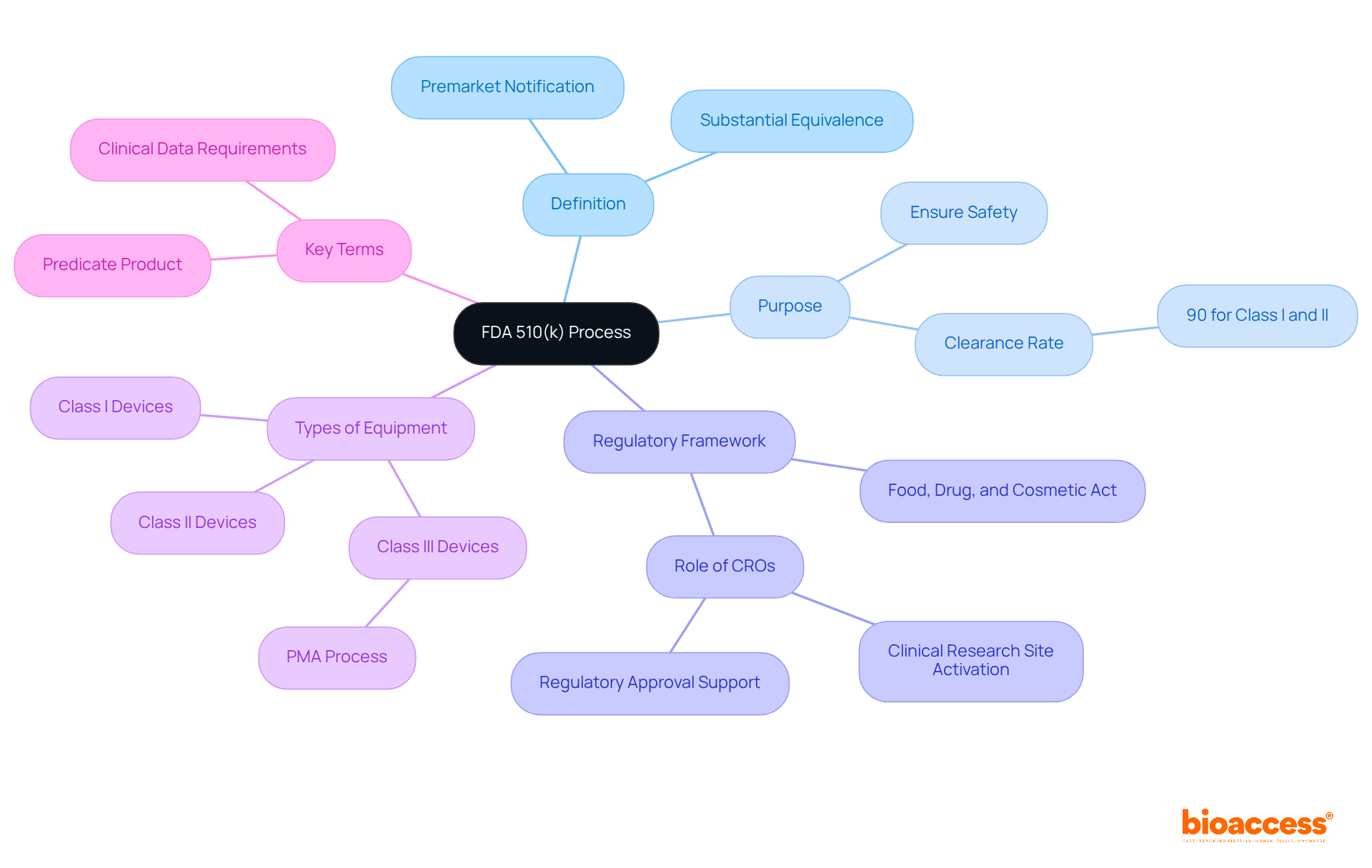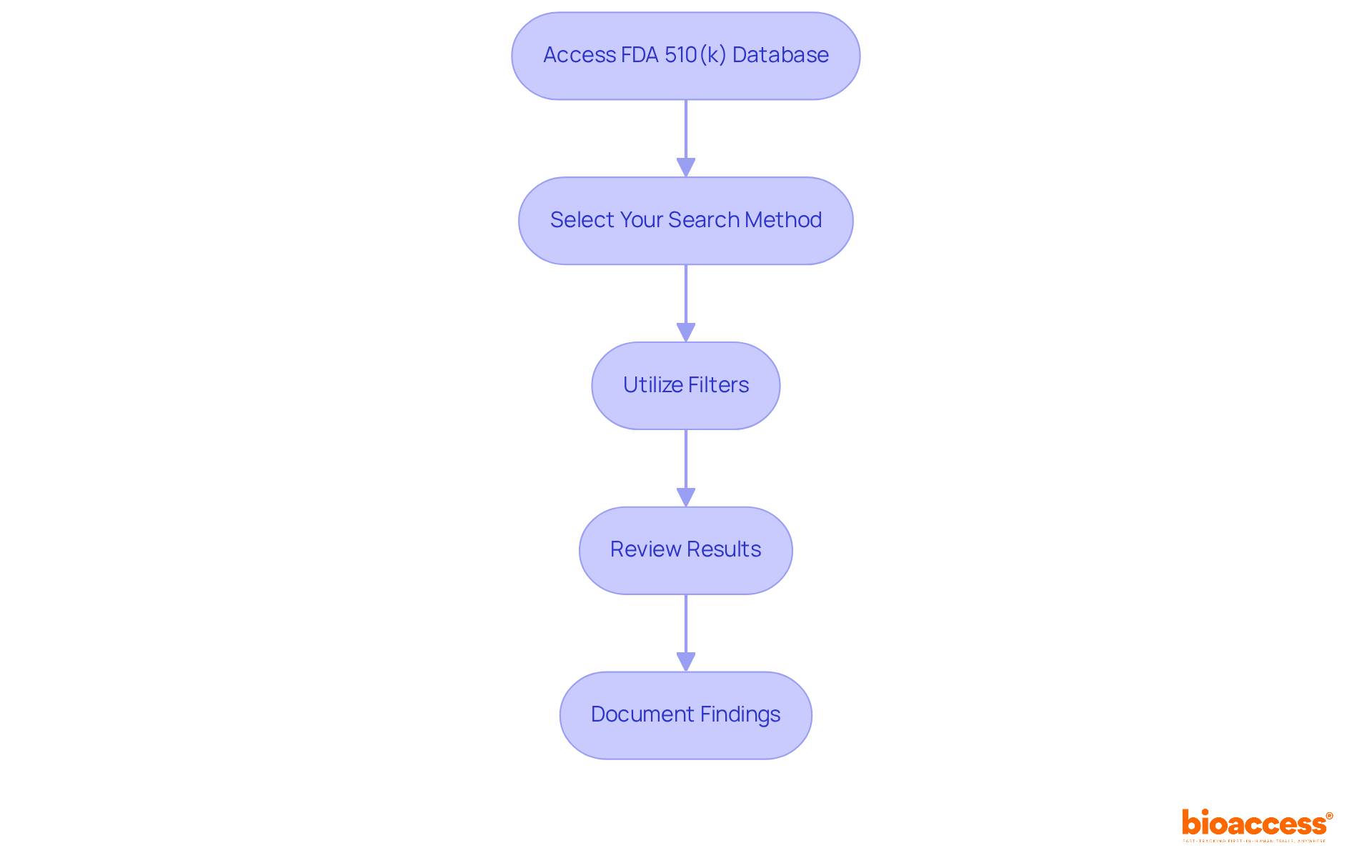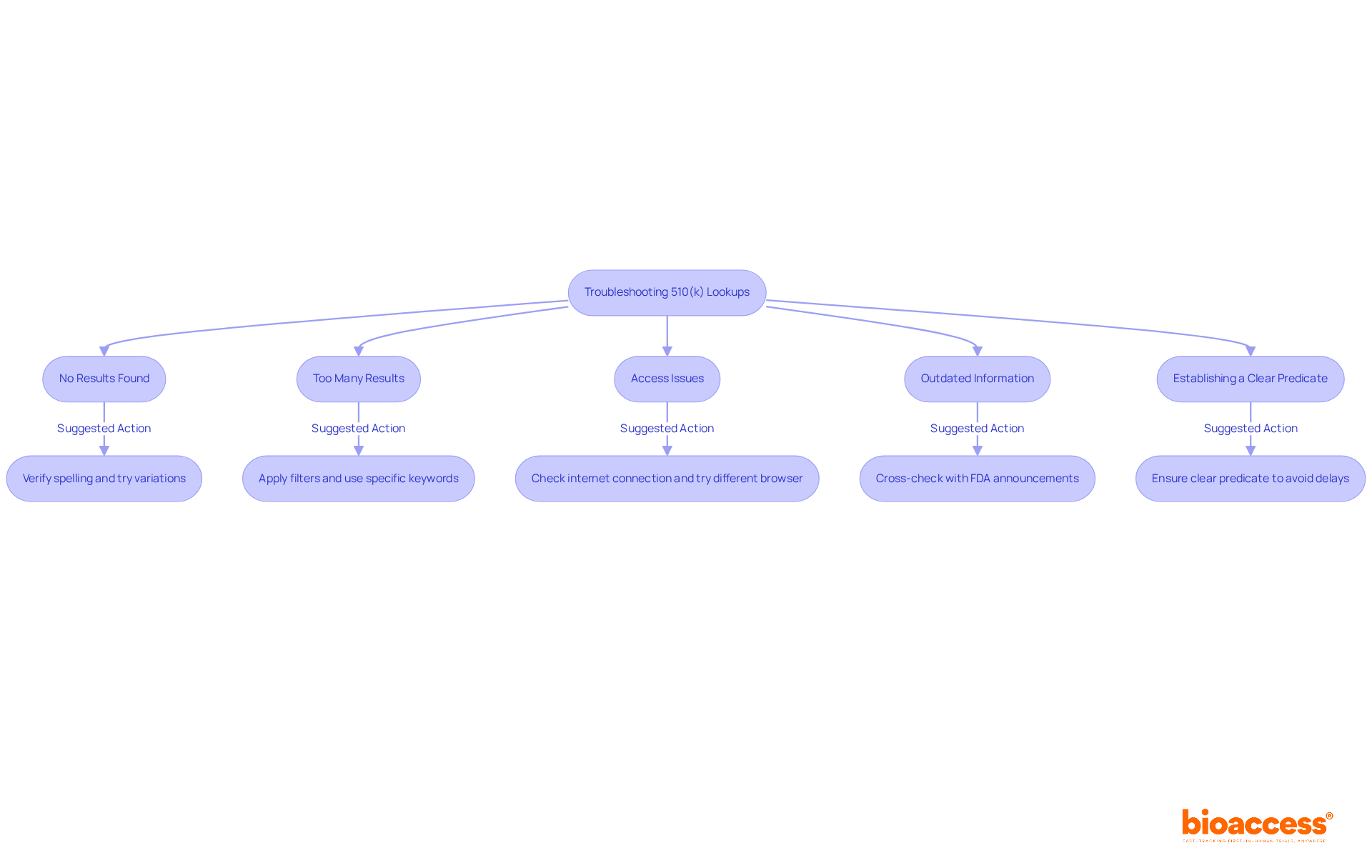


This article serves as a comprehensive guide to mastering the FDA 510(k) lookup process, outlining the essential steps and considerations necessary for effectively navigating this premarket submission for medical devices. It underscores the critical importance of understanding regulatory requirements and employing effective search strategies. Furthermore, leveraging available resources significantly enhances the likelihood of obtaining clearance. Supported by compelling statistics on submission success rates, the article highlights the significance of meticulous documentation in this process.
Navigating the FDA 510(k) lookup process can appear overwhelming; however, it is an essential step in confirming that medical devices adhere to safety and effectiveness standards prior to market entry. This guide provides a thorough examination of the 510(k) process, equipping readers with crucial strategies and insights designed to streamline their submissions and improve their chances of approval. Notably, with nearly a third of applications failing to pass initial reviews, how can companies adeptly traverse this intricate regulatory landscape and sidestep common pitfalls?
The fda 510k lookup process serves as a crucial premarket submission for specific medical products, aimed at demonstrating their safety and effectiveness, or substantial equivalence, to existing products. Understanding this process encompasses several essential components:
Recent changes to FDA 510(k) regulations have underscored the necessity for clear documentation and communication, which can be verified through an FDA 510k lookup. For instance, producers must anticipate possible inquiries from the FDA and provide detailed information regarding their product's intended use and technological features. Successful instances of tools that have obtained 510(k) clearance can be verified through the fda 510k lookup, which includes various types of diagnostic imaging apparatus and surgical instruments, underscoring the pathway's effectiveness in facilitating market entry for innovative medical technologies. Furthermore, it is essential to establish realistic expectations concerning the review timeline, as the FDA has a performance target of 90 days to issue a decision on 510(k) submissions, which may extend to an average of five months due to information requests. Once an apparatus receives approval, a company has 30 days to register the apparatus with the FDA. With bioaccess®'s expertise, Medtech startups can navigate these complexities more efficiently, ensuring a smoother path to commercialization.

To effectively search the FDA 510(k) database, follow these steps:
In 2021, the FDA managed an average of 3,000 510(k) applications each year, emphasizing the importance of effective FDA 510k lookup strategies. As Nick Tippmann noted, the FDA has introduced new pilot programs to enhance the consistency and efficiency of its 510(k) review process. Companies that adeptly navigate the FDA 510k lookup can significantly improve their likelihood of successful entries. For instance, utilizing the right filters can streamline the search process, allowing for quicker access to pertinent information. However, be aware of the challenges; nearly 32% of FDA 510(k) applications failed the acceptance for review check in the year leading up to September 2022. Thorough documentation of your findings can provide a solid foundation for your own regulatory submissions, ultimately facilitating quicker market entry.

Navigating the 510(k) database presents users with several common challenges. Here’s how to effectively troubleshoot these issues:
No Results Found: If your search yields no results, consider the following: verify the spelling of the device or applicant name and experiment with different variations of the apparatus name or broader search terms.
Too Many Results: If your search returns an overwhelming number of results, refine your approach by applying additional filters, such as product code or clearance date, and utilizing specific keywords that relate to the item's intended use.
Access Issues: Should you encounter difficulties accessing the database, confirm that your internet connection is stable and try accessing the site using a different browser or equipment.
Outdated Information: If you suspect the information may be outdated, cross-check by reviewing the FDA's official announcements or guidance documents for the most current updates regarding the 510(k) process.
Establishing a Clear Predicate: Remember that without a clear predicate, your device may face delays and increased costs in the clearance process. Establishing a clear predicate is essential for successful entries.
By following these troubleshooting steps, users can enhance their experience with the fda 510k lookup and achieve better search outcomes. As noted by regulatory experts, "Understanding the timeline and preparing for potential setbacks are crucial for a successful filing.

To optimize your efficiency when navigating the FDA 510(k) database, consider leveraging the following tools and resources:
FDA Guidance Documents: Stay informed by regularly reviewing the FDA's guidance documents, which are essential for understanding updates to the 510(k) process and optimal practices for applications. These documents clarify regulatory expectations and can significantly improve the quality of your entries by utilizing an fda 510k lookup.
Search Methods: Familiarize yourself with the two primary methods for conducting an FDA 510k lookup in the FDA 510(k) database: Quick search and Advanced search. The Quick search enables swift recognition of items using keywords, while the Advanced search offers more comprehensive filtering options based on specific criteria.
Third-Party Databases: Utilize external databases that gather 510(k) entries, providing advanced search functionalities and user-friendly interfaces. These platforms can streamline your search process, allowing for a more effective fda 510k lookup to identify relevant devices and regulatory attributes.
Webinars and Training: Engage in webinars or training sessions dedicated to the 510(k) process. These educational opportunities offer perspectives from industry specialists and keep you informed about the newest regulatory updates, which can be crucial for successful applications.
Professional Networks: Join professional networks or forums where industry peers share their experiences with the 510(k) process. Participating in these communities can yield practical tips and foster support, enhancing your understanding of common challenges and solutions.
Consultants: For intricate matters, think about hiring a regulatory advisor specializing in 510(k) applications. Their expertise can assist you in navigating regulatory challenges and enhancing the overall quality of your documents, ensuring compliance and efficiency.
Proactive Approaches: Implement proactive strategies such as manual searches in guidance documents and standards databases to stay ahead of regulatory changes. This method can deepen your comprehension of the regulatory environment and enhance outcomes.
By effectively utilizing these resources, you can enhance your search efficiency and increase your chances of successful applications through fda 510k lookup. Notably, 92.6% of 510(k)s remained free of recall five years after clearance, underscoring the importance of thorough submissions. As Soumya Mahapatra emphasizes, "Medical device manufacturers who intend to introduce a device into commercial distribution in the United States must submit a premarket notification - 510(k) or PMN to the FDA.

Mastering the FDA 510(k) lookup process is essential for medical device manufacturers aiming to navigate the complexities of regulatory submissions efficiently. This guide has illuminated the critical components of the 510(k) process, emphasizing the importance of understanding substantial equivalence, regulatory frameworks, and effective search strategies to ensure successful entries into the market.
Key insights include:
By leveraging tools such as FDA guidance documents, third-party databases, and professional networks, manufacturers can streamline their search for predicate devices and bolster their applications, ultimately increasing the likelihood of approval.
In conclusion, the FDA 510(k) lookup process is not merely a regulatory requirement but a vital step in ensuring that innovative medical technologies can reach the market safely and effectively. By adopting the strategies discussed and remaining informed about regulatory changes, manufacturers can position themselves for success in a competitive landscape. Embracing these practices will not only facilitate smoother submissions but also contribute to the overarching goal of enhancing patient safety and advancing healthcare solutions.
What is the FDA 510(k) process?
The FDA 510(k) process is a premarket submission for specific medical products that demonstrates their safety and effectiveness, or substantial equivalence, to existing products.
What is the purpose of a 510(k) submission?
The primary objective of a 510(k) submission is to ensure that new medical equipment does not introduce additional risks to patients compared to currently marketed instruments.
What percentage of 510(k) submissions receive clearance?
Approximately 90% of 510(k) submissions for Class I and Class II devices receive clearance, allowing them to be marketed in the U.S.
What regulations are important for the 510(k) process?
Familiarity with the Food, Drug, and Cosmetic Act and other relevant regulations is vital for navigating the 510(k) process effectively.
What types of products are primarily affected by the 510(k) process?
The 510(k) process primarily applies to Class I and Class II medical devices, while Class III items typically require a more rigorous Premarket Approval (PMA) process.
What are key terms to understand in the 510(k) process?
Key terms include 'predicate product', which refers to the existing item your product is compared to, and 'substantial equivalence', which means demonstrating that your product is as safe and effective as the predicate.
How can producers prepare for FDA inquiries during the 510(k) process?
Producers should anticipate possible inquiries from the FDA and provide detailed information regarding their product's intended use and technological features.
What is the typical review timeline for a 510(k) submission?
The FDA has a performance target of 90 days to issue a decision on 510(k) submissions, but this may extend to an average of five months due to information requests.
What must a company do after receiving 510(k) approval?
Once an apparatus receives 510(k) approval, the company has 30 days to register the apparatus with the FDA.
How can companies like bioaccess® assist in the 510(k) process?
Bioaccess® can offer invaluable support in regulatory approval, clinical research site activation, subject recruitment, and trial data management, helping Medtech startups navigate the complexities of the 510(k) process more efficiently.